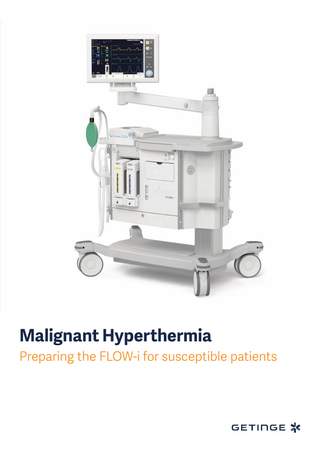Guide
4 Pages

Preview
Page 1
Malignant Hyperthermia Preparing the FLOW-i for susceptible patients
Malignant Hyperthermia Washout procedure
Malignant hyperthermia (MH) - causes, effects and treatment Malignant hyperthermia (malignant hyperpyrexia) is a condition caused by an uncontrolled release of Ca2+ from calcium deposits in the muscle tissue. Triggering factors include certain drugs used for general anaesthesia, such as the volatile anesthetic agents Desflurane, Sevoflurane and Isoflurane and the neuromuscular blocking agent succinylcholine1,2. The extreme levels of Ca induce drastically increased oxdative metabolism in the skeletal muscles. The demand for oxgen increases and carbon dioxide accumulates in the body. End tidal concentration of CO2 increases as a result. 2+
The ability to regulate body temperature also decreases. These effects may, if left untreated, lead to multi organ failure and death1,3. The only known treatment after onset of MH is intravenous administration of dantrolene and supportive therapy to combat the symptoms2. This, together with preventive measures, has contributed to a decrease in the mortality rate from around 80% during the 1970, to less than 5% today2-5. The majority of patients developing MH havemutations in receptors regulating intracellular levels of Ca2+ in muscle tissues. These genotypic variants predispose individuals to develop MH when challenged with triggering factors1,6.
Incidence Estimates of the number of susceptible individuals range from 1 in 2000 to 1 in 3000, based on patient genotyping and review of the relatives’ medical histories4. The incidence of MH ranges from 1 in 10 000 to 1 in 220 000 general anaesthesia procedures. Reported cases indicate a bias towards younger patients and male patients3,4,7.
Preventive measures when working with the FLOW-i anaesthesia system During a patient case using Sevoflurane, Isoflurane or Desflurane, a small amount of the agent is absorbed and retained by the parts comprising the breathing circuit. After delivery of agent has been discontinued, absorbed agent is released into the breathing circuit volume. Typical levels are in the ppm (parts per million) range, e.g. 30-60 ppm10. The level of anaesthetic agent in the breathing circuit gas volume decreases with time when ventilating using fresh gas only. The illustration to the right shows a typical decrease in detectable agent when a washout procedure is implemented. While the minimum dose for triggering MH is unknown, a consensus concentration of ≤5.0 ppm has been adopted when preparing anaesthetic systems for patients with a known history of MH, or who are suspected of being predisposed to MH8-10.
[Agent] ppm
Time (t)
Detectable concentrations of agent in the breathing circuit gas volume. The initial level of agent and clearance rate depend primarily on agent solubility in the parts comprising the anaesthetic system10.
A
Washout procedure 2 min.
The following procedure describes how to clear the FLOW-i of remaining anaesthetic agent so as to ensure an agent level <5 ppm. 1. Disconnect the absorber and vaporiser. Discard the absorber. 2. Connect the Y-piece to the SCO plug. 3. Ventilate vigorously for 2 minutes using manual (MAN) ventilation with a FGF setting of 20 l/min and an APL setting of 10 cmH2O (A). Go to standby when completed. 4. Replace the patient cassette, volume reflector and volume reflector adapter with parts cleaned in a washer-disinfector. Refer to the user documentation for information regarding cleaning procedures.
B
5. Replace the patient tubings, manual breathing bag, sampling line and water trap with new parts (B). 6. Connect the Y-piece to the SCO plug and ventilate vigorously for 5 minutes using the same settings as in step 3. Thereafter, leave the system for 120 minutes in MAN mode with the fresh gas flow still at 20 l/min (C). 7. Turn off Manual ventilation. Attach a new absorber.
C 5 min.
+
120 min.
References 1 Carpenter D, Robinson RL, Quinnell RJ, Ringrose C, Hogg M, Casson F, Booms P, Iles DE, Halsall PJ, Steele DS, Shaw MA, Hopkins PM. Genetic variation in RYR1
and malignant hyperthermia phenotypes. Br J Anaesthesiology. 2009 Oct;103(4):538-48. 2 Hopkins PM. Malignant hyperthermia: pharmacology of triggering. Br J Anaesthesiology. 2011 May;107(1):48-56. 3
Rosero EB, Adesanya AO, Timaran CH, Joshi GP. Trends and outcomes of malignant huperthermia in the United States, 2000-2005. Anesthesiology 2009;110:89-94.
4
Brady JE, Sun LS, Rosenberg H, Li G. Prevalence of malignant hyperthermia due to anesthesia in New York State, 2001-2005. Anesth Analg. 2009 Oct;109(4):1162-6.
5
Litman RS, Rosenberg H. Malignant hyperthermia: update on susceptibility testing. JAMA. 2005 Jun 15;293(23):2918-24.
6
Monnier N, Kozak-Ribbens G, Krivosic-Horber R, NivocheY, Qi D, Kraev N, Loke J, Sharma P, Tegazzin V, Figarella-Branger D, Roméro N, Mezin P, Bendahan D, Payen JF, Depret T, Maclennan DH, Lunardi J. Correlations between genotype and pharmacological, histological, functional and clinical phenotypes in malignant hyperthermia susceptibility. Hum Mutat 2005; 26:413-25.
7
Sumitani M, Uchida K, Yasunaga H, Horiguchi H, Kusakabe Y, Matsuda S, Yamada Y. Prevalence of malignant hyperthermia and relationship with anesthetics in Japan. Anesthesiology
2011 Jan;114(1):84-90. 8
Brünner HW, Pohl S, Grond S. Washout of sevoflurane from the GE Avance and Amingo Carestation anesthetic machines. Acta Anaesthesiol Scand 2011;55:1118-1123.
9
Prinzhauses H, Crawford MW, O’Rourke J, Petroz GC. Preparation of the Dräger Primus anesthetic machine for malignant hyperthermia susceptible patients. Can J Anesth 2006;53:885-90.
10
Kim TW, Nemergut ME. Preparation of moderna anesthesia workstations for malignant hyperthermia-susceptible patients. Anesthesiology 2011; 114:205-12
With a firm belief that every person and community should have access to the best possible care, Getinge provides hospitals and life science institutions with products and solutions aiming to improve clinical results and optimise workflows. The offering includes products and solutions for intensive care, cardiovascular procedures, operating rooms, sterile reprocessing and life science. Getinge employs over 10,000 people worldwide and the products are sold in more than 135 countries. © 2019 Getinge Australia Pty Ltd ABN 67 009 673 518 Australian Phone: 1800 438 464 Email: [email protected] New Zealand Phone: 0800 1 438 4643 Email: [email protected] www.getinge.com/anz
ANZ_CC_V1_053_0719